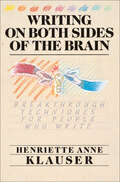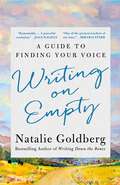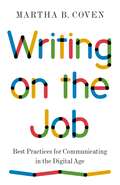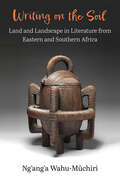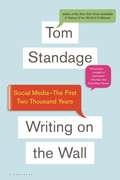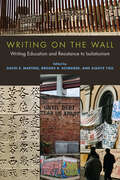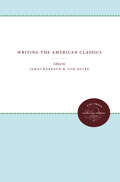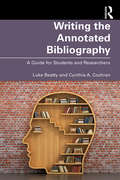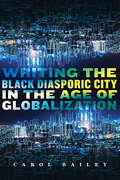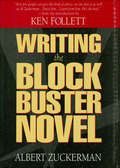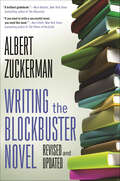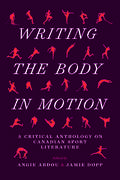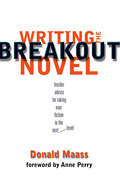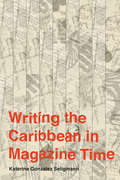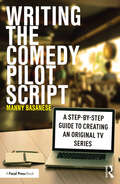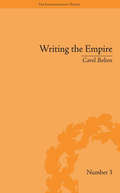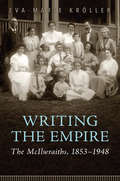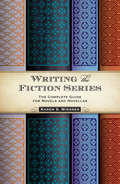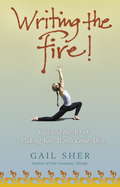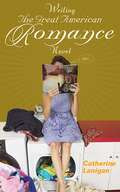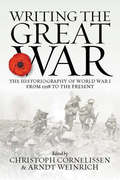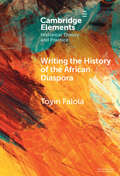- Table View
- List View
Writing on Both Sides of the Brain: Breakthrough Techniques for People Who Write
by Henriette Anne KlauserA revolutionary approach to writing that will teach you how to express yourself fluently and with confidence for the rest of your life.In Writing on Both Sides of the Brain, author Henriette Anne Klauser offers writers breakthrough techniques to break through blocks and create and communicate yourself through words. From working with procrastination and fending off your inner critic to organizing your material and using creative visualization, this informative and empowering guide will help demystify the Right Brain/Left Brain thought processes and keep your words flowing.“Definitely supportive. The biggest block any writer has is self-judgment. Writing on Both Sides of the Brain helps overcome the obstacles and tap into the creative powers within each writer.” —W. Timothy Gallwey, bestselling author of The Inner Game of Tennis“Amusing, interesting, and stimulating . . . should help many potential writers.” —Pulitzer Prize winner Donald M. Murray
Writing on Empty: A Guide to Finding Your Voice
by Natalie GoldbergBestselling author and teacher Natalie Goldberg shares her inspiring personal journey out of a devastating period of writer’s block and back into a life of growth, creativity, and healing.Natalie Goldberg has been writing for the past fifty years. But at the beginning of the pandemic, she suddenly wasn’t able to write anymore. Her imaginative wellspring had dried up, and she was forced to ask herself: what do I do when what has always worked for me doesn’t work anymore?In this beautifully written, inspiring personal account, Natalie shares her harrowing journey out of creative paralysis and back onto the page. When all of her tried and true methods – meditation, sitting still, writing practice – stopped working, she had to take drastic action. She got into her car and left New Mexico in search of a new inventive source. In her journey through the western states, she visited famous literary sites, searching for the spark that would reignite her ability to write.And, next to Hemingway’s grave, she found it. “Get going,” he seemed to say to her, and she did. Now, Natalie shares her story of traveling through literary and personal memory to clarify her way forward, struggling to make sense of her difficult relationships with parents and teachers, and digging into her long-held grief. Ultimately, she discovers how to write through the emptiness in order to fill up the world with compassion, healing, and renewed liveliness.For anyone struggling to reconnect with their own creative source, Writing on Empty is a gentle and instructive guidebook back to remembering what truly matters.
Writing on the Job: Best Practices for Communicating in the Digital Age
by Martha B. CovenA practical and compact guide to writing for professionalsWriting is an essential skill in today’s workplace. From messaging platforms and social media to traditional forms of communication like memos and reports, we rely on words more than ever. Given how much reading we do on mobile devices, being able to write succinctly is critical to success. Writing on the Job is an incisive guide to clear and effective writing for professionals.Martha Coven begins with the basics, explaining how to develop a professional style, get started on a piece of writing, create a first draft, and edit it into a strong final product. She then offers practical advice on more than a dozen forms of writing, from emails and slide decks to proposals and cover letters. Along the way, Coven provides a wealth of concrete examples and simple templates that make the concepts easy to understand and apply.Based on Coven’s popular writing classes and workshops at Princeton University as well as her decades of experience in the public and private sectors, Writing on the Job addresses the real challenges professionals face in today’s digital age, and shares essential practices that can improve the performance of any organization.
Writing on the Soil: Land and Landscape in Literature from Eastern and Southern Africa (African Perspectives)
by Ng'ang'a Wahu-MuchiriAcross contiguous nation-states in Eastern Africa, the geographic proximity disguises an ideological complexity. Land has meant something fundamental in the sociocultural history of each country. Those concerns, however, have manifested into varied political events, and the range of struggles over land has spawned a multiplicity of literary interventions. While Kenya and Uganda were both British colonies, Kenya's experience of settler land alienation made for a much more violent response against efforts at political independence. Uganda's relatively calm unyoking from the colonial burden, however, led to a tumultuous post-independence. Tanzania, too, like Kenya and Uganda, resisted British colonial administration—after Germany's defeat in World War 1. In Writing on the Soil, author Ng’ang’a Wahu-Mũchiri argues that representations of land and landscape perform significant metaphorical labor in African literatures, and this argument evolves across several geographical spaces. Each chapter's analysis is grounded in a particular locale: western Kenya, colonial Tanganyika, post-independence Tanzania, Zimbabwe, Nairobi, Dar es Salaam, Anam Ka'alakol (Lake Turkana), Kampala, and Kitgum in Northern Uganda. Moreover, each section contributes to a deeper understanding of the aesthetic choices that authors make when deploying tropes revolving around land, landscape, and the environment. Mũchiri disentangles the numerous connections between geography and geopolitical space on the one hand, and ideology and cultural analysis on the other. This book embodies a multi-layered argument in the sphere of African critical scholarship, while adding to the growing field of African land rights scholarship—an approach that foregrounds the close reading of Africa’s literary canon.
Writing on the Wall: Social Media--The First 2,000 Years
by Tom StandageThe Catholic Church's dilemmas in responding to Martin Luther's attacks are similar to those of today's large institutions in responding to criticism on the Internet, for example, and seventeenth-century complaints about the distractions of coffeehouses mirror modern concerns about social media. Invoking figures from Thomas Paine to Vinton Cerf, co-inventor of the Internet, Standage explores themes that have long been debated, from the tension between freedom of expression and censorship to social media's role in spurring innovation and fomenting revolution.
Writing on the Wall: Writing Education and Resistance to Isolationism
by David S. Martins Xiaoye You Brooke R. SchreiberThe first concerted effort of writing studies scholars to interrogate isolationism in the United States, Writing on the Wall reveals how writing teachers—often working directly with students who are immigrants, undocumented, first-generation, international, and students of color—embody ideas that counter isolationism. The collection extends existing scholarship and research about the ways racist and colonial rhetorics impact writing education; the impact of translingual, transnational, and cosmopolitan ideologies on student learning and student writing; and the role international educational partnerships play in pushing back against isolationist ideologies. Established and early-career scholars who work in a broad range of institutional contexts highlight the historical connections among monolingualism, racism, and white nationalism and introduce community- and classroom-based practices that writing teachers use to resist isolationist beliefs and tendencies. “Writing on the wall” serves as a metaphor for the creative, direct action writing education can provide and invokes border spaces as sites of identity expression, belonging, and resistance. The book connects transnational writing education with the fight for racial justice in the US and around the world and will be of significance to secondary and postsecondary writing teachers and graduate students in English, linguistics, composition, and literacy studies. Contributors: Olga Aksakalova, Sara P. Alvarez, Brody Bluemel, Tuli Chatterji, Keith Gilyard, Joleen Hanson, Florianne Jimenez Perzan, Rebecca Lorimer Leonard, Layli Maria Miron, Tony D. Scott, Kate Vieira, Amy J. Wan
Writing the 1926 General Strike
by Charles FerrallCharles Ferrall and Dougal McNeill's book analyses the vast literary response to the 1926 General Strike . The Strike not only drew writers into political action but inspired literature that served to shape twentieth-century British views of class, culture and politics. While major figures active at the time wrote on or responded to this crucial moment, this is the first volume to address their respective works. Ferrall and McNeill show how novels then in progress, such as Virginia Woolf's To the Lighthouse and D. H. Lawrence's Lady Chatterley's Lover, were affected by the Strike as well as the ways in which it has been remembered from the 1930s to the present. Their study sheds new light on the relationship between politics and literature of the modernist era.
Writing the American Classics
by James Barbour and Tom QuirkThis collection of essays describes the genesis of ten classic works of American literature. Using biographical, cultural, and manuscript evidence, the contributors tell the "stories of stories," plotting the often curious and always interesting ways in which notable American books took shape in a writer's mind.The genetic approach taken in these essays derives from a curiosity, and sometimes a feeling of awe, about how a work of literature came to exist -- what motivated its creation, informed its vision, urged its completion. It is just that sort of wonder that first brings some people to love writers and their books.Originally published in 1990.A UNC Press Enduring Edition -- UNC Press Enduring Editions use the latest in digital technology to make available again books from our distinguished backlist that were previously out of print. These editions are published unaltered from the original, and are presented in affordable paperback formats, bringing readers both historical and cultural value.
Writing the Annotated Bibliography: A Guide for Students & Researchers
by Luke Beatty Cynthia A CochranThis comprehensive and practical guide covers the elements, style, and use of annotated bibliographies in the research and writing process for any discipline; key disciplinary conventions; and tips for working with digital sources. Written jointly by a library director and a writing center director, this book is packed with examples of individual bibliography entries and full bibliography formats for a wide range of academic needs. Online resources include sample bibliographies, relevant web links, printable versions of checklists and figures, and further resources for instructors and researchers. Writing the Annotated Bibliography is an essential resource for first-year and advanced composition classes, courses in writing across the disciplines, graduate programs, library science instruction programs, and academic libraries at the secondary level and beyond. It is suitable for both undergraduate and graduate students and for researchers at all levels.
Writing the Black Diasporic City in the Age of Globalization
by Carol BaileyWriting the Black Diasporic City in the Age of Globalization theorizes the city as a generative, “semicircular” social space, where the changes of globalization are most profoundly experienced. The fictive accounts analyzed here configure cities as spaces where movement is simultaneously restrictive and liberating, and where life prospects are at once promising and daunting. In their depictions of the urban experiences of peoples of African descent, writers and other creative artists offer a complex set of renditions of twentieth- and twenty-first-century Black urban citizens’ experience in European or Euro-dominated cities such as Boston, London, New York, and Toronto, as well as Global South cities such as Accra, Kingston, and Lagos—that emerged out of colonial domination, and which have emerged as hubs of current globalization. Writing the Black Diasporic City draws on critical tools of classical postcolonial studies as well as those of globalization studies to read works by Ama Ata Aidoo, Amma Darko, Marlon James, Cecil Foster, Zadie Smith, Michael Thomas, Chika Unigwe, and other contemporary writers. The book also engages the television series Call the Midwife, the Canada carnival celebration Caribana, and the film series Small Axe to show how cities are characterized as open, complicated spaces that are constantly shifting. Cities collapse boundaries, allowing for both haunting and healing, and they can sever the connection from kin and community, or create new connections.
Writing the Blockbuster Novel
by Al ZuckermanEvery novelist dreams of it--writing the book that rockets to the top of the best-seller lists. Now, they can see how it's done, up close, in a book by an agent who has sold manuscripts that turned into hits.<P><P> Here Albert Zuckerman covers the essential elements of the blockbuster novel and shows writers how to put them to work in their books. Zuckerman covers the subject thoroughly, from creating outlines and building larger than life characters to injecting suspense and more. His instruction is decisive, direct and clear and is supported with examples from Gone With the Wind, The Godfather and other blockbusters.
Writing the Blockbuster Novel
by Albert ZuckermanAlbert Zuckerman, legendary literary agent, has worked with many bestselling authors, including Ken Follett, Olivia Goldsmith, Antoinette Van Heugten, Michael Lewis, and F. Paul Wilson. Zuckerman is a master at teaching writers the skills necessary to crack the bestseller list. For this revised edition of Writing the Blockbuster Novel, Zuckerman has added an analysis of Nora Roberts's The Witness, which he uses along with classic books like Gone With the Wind and The Godfather, to illustrate his points. Zuckerman's commentary on Ken Follett's working outlines for The Man From St. Petersburg provide a blueprint for building links between plot and character. A new introduction discusses social media and self-publishing.Writing the Blockbuster Novel is an essential tool for any aspiring author. As Dan Brown said in an interview: "Not long ago, I had an amusing experience meeting the author of a book I received as a gift nearly two decades ago a book that in many ways changed my life. I was halfway through writing my first novel when I was given a copy of Writing the Blockbuster Novel. [Zuckerman's] book helped me complete my manuscript and get it published. [When] I met Mr. Zuckerman for the first time. I gratefully told him that he had helped me. He jokingly replied that he planned to tell everyone that he had helped me write The Da Vinci Code."At the Publisher's request, this title is being sold without Digital Rights Management Software (DRM) applied.
Writing the Body in Motion: A Critical Anthology on Canadian Sport Literature
by Angie Abdou Jamie DoppSport literature is never just about sport. The genre’s potential to explore the human condition, including aspects of violence, gender, and the body, has sparked the interest of writers, readers, and scholars. Over the last decade, a proliferation of sport literature courses across the continent is evidence of the sophisticated and evolving body of work developing in this area. Writing the Body in Motion offers introductory essays on the most commonly taught Canadian sport literature texts. The contributions sketch the state of current scholarship, highlight recurring themes and patterns, and offer close readings of key works. Organized chronologically by source text, ranging from Shoeless Joe (1982) to Indian Horse (2012), the essays offer a variety of ways to read, consider, teach, and write about sport literature.
Writing the Breakout Novel: Winning Advice From A Top Agent And His Bestselling Client
by Donald MaassMake Your Novel Stand Out from the Crowd! Noted literary agent and author Donald Maass has done it again! His previous book,Writing the Breakout Novel, offered novelists of all skill levels and genres insider advice on how to make their books rise above the competition and succeed in a crowded marketplace. Now, building on the success of its predecessor,Writing the Breakout Novel Workbookcalls that advice into action! This powerful book presents the patented techniques and writing exercises from Maass's popular writing workshops to offer novelists first-class instruction and practical guidance. You'll learn to develop and strengthen aspects of your prose with sections on: Building plot layers Creating inner conflict Strengthening voice and point of view Discovering and heightening larger-than-life character qualities Strengthening theme And much more! Maass also carefully dissects examples from real-life breakout novels so you'll lean how to read and analyze fiction like a writer. With authoritative instruction and hands-on workbook exercises,Writing the Breakout Novel Workbookis one of the most accessible novel-writing guides available. Set your work-in progress apart from the competition and write your own breakout novel today!
Writing the Caribbean in Magazine Time (Critical Caribbean Studies)
by Katerina Gonzalez SeligmannWriting the Caribbean in Magazine Time examines literary magazines generated during the 1940s that catapulted Caribbean literature into greater international circulation and contributed significantly to social, political, and aesthetic frameworks for decolonization, including Pan-Caribbean discourse. This book demonstrates the material, political, and aesthetic dimensions of Pan-Caribbean literary discourse in magazine texts by Suzanne and Aimé Césaire, Nicolás Guillén, José Lezama Lima, Alejo Carpentier, George Lamming, Derek Walcott and their contemporaries. Although local infrastructure for book production in the insular Caribbean was minimal throughout the twentieth century, books, largely produced abroad, have remained primary objects of inquiry for Caribbean intellectuals. The critical focus on books has obscured the canonical centrality of literary magazines to Caribbean literature, politics, and social theory. Up against the imperial Goliath of the global book industry, Caribbean literary magazines have waged a guerrilla pursuit for the terms of Caribbean representation.
Writing the City: Urban Visions and Literary Modernism (Literary Criticism and Cultural Theory)
by Desmond HardingWriting the City examines and challenges the traditional transatlantic axis of urban modernism, London-Paris-New York, an axis that has often elided the historical importance of other centers that have shaped metropolitan identities and discourses. According to Desmond Harding, James Joyce's internationalist vision of Dublin generates powerful epistemic and cultural tropes that reconceive the idea of the modern city as a moral phenomenon in transcultural and transhistorical terms. Taking up the works of both Joyce and John Dos Passos, Harding investigates the lasting contributions these author's made to transatlantic intellectual thought in their efforts to envisage the city.
Writing the Classroom: Pedagogical Documents as Rhetorical Genres
by Megan Knight Lori Ostergaard Jim Nugent Lora Arduser Christina Saidy Kate Navickas Logan Bearden Megan Schoen Michael Albright Virginia M. Schwarz Jessica Rivera-Mueller Dustin Morris Lindsay Clark Amy Ferdinandt Stolley Christopher Toth Dana Comi Mark A. Hannah Matt Dowell Cindy Mooty Lesley Erin Bartlett Laura R. Micciche Cynthia Pengilly Kate Nesbit Zack K. De PieroWriting the Classroom explores how faculty compose and use pedagogical documents to establish classroom expectations and teaching practices, as well as to articulate the professional identities they perform both inside and outside the classroom. The contributors to this unique collection employ a wide range of methodological frameworks to demonstrate how pedagogical genres—even ones as seemingly straightforward as the class syllabus—have lives extending well beyond the classroom as they become part of how college teachers represent their own academic identities, advocate for pedagogical values, and negotiate the many external forces that influence the act of teaching. Writing the Classroom shines a light on genres that are often treated as two-dimensional, with purely functional purposes, arguing instead that genres like assignment prompts, course proposals, teaching statements, and policy documents play a fundamental role in constructing the classroom and the broader pedagogical enterprise within academia. Writing the Classroom calls on experienced teachers and faculty administrators to critically consider their own engagement with pedagogical genres and offers graduate students and newer faculty insight into the genres that they may only now be learning to inhabit as they seek to establish their personal teacherly identities. It showcases the rhetorical complexity of the genres written in the service of pedagogy not only for students but also for the many other audiences within academia that have a role in shaping the experience of teaching. Contributors: Michael Albright, Lora Arduser, Lesley Erin Bartlett, Logan Bearden, Lindsay Clark, Dana Comi, Zack K. De Piero, Matt Dowell, Amy Ferdinandt Stolley, Mark A. Hannah, Megan Knight, Laura R. Micciche, Cindy Mooty, Dustin Morris, Kate Navickas, Kate Nesbit, Jim Nugent, Lori A. Ostergaard, Cynthia Pengilly, Jessica Rivera-Mueller, Christina Saidy, Megan Schoen, Virginia Schwarz, Christopher Toth
Writing the Comedy Pilot Script: A Step-by-Step Guide to Creating an Original TV Series
by Manny BasaneseNavigating through the challenging process of writing a comedy pilot, this book will help screenwriters to create an original script for television. Practical and accessible, the book presents a step-by-step guide focusing on the key elements of the process. Incorporating both the history of TV comedy as well as its current evolving state in this age of the dramedy and an ever-increasing variety of broadcast and streaming platforms, the book will serve as a guide for the fledgling sitcom scribe. Author Manny Basanese breaks down the comedy pilot writing process from what may be perceived as an overwhelming, time-consuming mission into a series of much more manageable, smaller steps (from logline to outline to 1st, 2nd and polished draft). Utilizing his experience in Hollywood’s sitcom trenches, the author offers real-world advice on such topics as building the comedy pilot "world," creating memorable comic characters, sound sitcom structure, and the importance of crafting an emotional through line in a comedy pilot. Finally, there is also practical career guidance for marketing this just-completed script and breaking into the industry with advice on various topics such as the value of networking as well as gaining representation in the competitive Hollywood jungle. It is ideal for students of screenwriting and aspiring comedy screenwriters.
Writing the Empire: Robert Southey and Romantic Colonialism (The Enlightenment World #3)
by Carol BoltonExamines a range of Robert Southey's writing to explore the relationship between Romantic literature and colonial politics during the expansion of Britain's second empire. This study draws upon a range of interdisciplinary materials to consider the impact of his work upon nineteenth-century views of empire.
Writing the Empire: The McIlwraiths, 1853–1948
by Eva-Marie KröllerWriting the Empire is a collective biography of the McIlwraiths, a family of politicians, entrepreneurs, businesspeople, scientists, and scholars. Known for their contributions to literature, politics, and anthropology, the McIlwraiths originated in Ayrshire, Scotland, and spread across the British Empire, specifically North America and Australia, from the mid-nineteenth century onwards. Focusing on imperial networking, Writing the Empire reflects on three generations of the McIlwraiths’ life writing, including correspondence, diaries, memoirs, and estate papers, along with published works by members of the family. By moving from generation to generation, but also from one stage of a person’s life to the next, the author investigates how various McIlwraiths, both men and women, articulated their identity as subjects of the British Empire over time. Eva-Marie Kröller identifies parallel and competing forms of communication that involved major public figures beyond the family’s immediate circle, and explores the challenges issued by Indigenous people to imperial ideologies. Drawing from private papers and public archives, Writing the Empire is an illuminating biography that will appeal to readers interested in the links between life writing and imperial history.
Writing the Fiction Series: The Complete Guide for Novels and Novellas
by Karen S. WiesnerWhat are the common pitfalls in a crafting a series, the best ways to get organized and plan it? The purpose of Writing the Fiction Series is to cover all things that need to be taken into consideration when writing a series and provide a one-stop resource for the who, what, where, when and why of this monumental endeavor. This helpful guide will give writers everything they need for creating their fiction series from dealing with story arcs and keeping things focused to characters, consistency, organization and more.
Writing the Fire! Yoga and the Art of Making Your Words Come Alive
by Gail SherWriting the Fire! offers writers a new and visionary practice: using yoga to release the body's inner intelligence and then support, shape, and inform the creative process. Indeed, "writing is yoga," declares Gail Sher, introducing the "writing asana"--an invaluable new tool for every writer's routine. Her insightful and lyrical book, organized around eight thematic "immersions," plumbs yoga's wisdom heritage. As Donald Moyer, director of the Yoga Room in Berkeley, comments, "She encourages writers to approach their writing with the clarity and presence of yogis, and teaches yogis how to temper their awareness with the heat of words and images." Writing the Fire! celebrates the fullest expression of our being.
Writing the Great American Romance Novel
by Catherine LaniganThe complete guide to turning romances into cash. Romance novels are the top-selling genre in fiction. How can aspiring writers break into this lucrative field? With Writing the Great American Romance Novel, the most complete guide to writing that novel, getting it published, working with editors, agents, and publicists, and promoting it once it's out! Step-by-step instruction shows how to create romantic heroes and heroines, structure a story, and write love scenes, as well as how to plan outlines, use timelines and grids, conduct personal interviews, and do historical research. With extras such as a list of publishers, a sample press release, a sample synopsis, and much more, this book is must-have for any aspiring romance writer passionate about writing. Romance accounts for $1.2 billion in sales and 55 percent of the paperback market The group Romance Writers of America has almost 10,000 members Takes writers beyond writing to selling and promotion
Writing the Great War: The Historiography of World War I from 1918 to the Present
by Christoph Cornelissen and Arndt WeinrichFrom the Treaty of Versailles to the 2018 centenary and beyond, the history of the First World War has been continually written and rewritten, studied and contested, producing a rich historiography shaped by the social and cultural circumstances of its creation. Writing the Great War provides a groundbreaking survey of this vast body of work, assembling contributions on a variety of national and regional historiographies from some of the most prominent scholars in the field. By analyzing perceptions of the war in contexts ranging from Nazi Germany to India’s struggle for independence, this is an illuminating collective study of the complex interplay of memory and history.
Writing the History of the African Diaspora (Elements in Historical Theory and Practice)
by Toyin FalolaThis Element is an analysis of the African Diaspora. It will define the African Diaspora and how the concepts behind the term came to be socially and historically engineered. The African diaspora is then placed into a broader historical context where the diverse, global, and overlapping histories of Africa's ancient-ongoing diasporas will be explored. In particular, themes of injustice, agency, resistance, and diversity (regarding people, diasporas, and experiences) will feature heavily. Through this exploration, this Element will interrogate dominating narratives regarding African diaspora-related discourse, seeking to address prevailing ideas that inadequately capture the true complexity and nuance of the subject. It does so to construct a more comprehensive understanding of the subject matter while lining out a more holistic approach to thinking about the very nature of 'diaspora.' Finally, this Element will analyze the present circumstances of the African diaspora, bringing into conversation a progressively global and connected world.
